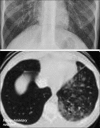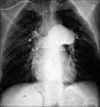Pulmonary vascular complications of chronic liver disease: Pathophysiology, imaging, and treatment
- PMID: 21572693
- PMCID: PMC3081557
- DOI: 10.4103/1817-1737.78412
Pulmonary vascular complications of chronic liver disease: Pathophysiology, imaging, and treatment
Abstract
To review the pathogenesis of pulmonary vascular complications of liver disease, we discuss their clinical implications, and therapeutic considerations, with emphasis on potential reversibility of the hepatopulmonary syndrome after liver transplantation. In this review, we also discuss the role of imaging in pulmonary vascular complications associated with liver disease.
Keywords: Hepatopulmonary syndrome; Yttrium-90 microsphere embolization hepatocellular carcinoma; portopulmonary hypertension; pulmonary arteriovenous shunts.
Conflict of interest statement
Figures













Similar articles
-
Hepatopulmonary syndrome and portopulmonary hypertension.Hepatol Res. 2009 Oct;39(10):1020-2. doi: 10.1111/j.1872-034X.2009.00552.x. Hepatol Res. 2009. PMID: 19796040
-
Hepatopulmonary syndrome and portopulmonary hypertension: recent knowledge in pathogenesis and overview of clinical assessment.Liver Int. 2015 Jun;35(6):1646-60. doi: 10.1111/liv.12791. Epub 2015 Feb 16. Liver Int. 2015. PMID: 25627425 Review.
-
Coexisting hepatopulmonary syndrome and portopulmonary hypertension: implications for liver transplantation.J Clin Gastroenterol. 2010 Aug;44(7):e136-40. doi: 10.1097/MCG.0b013e3181da76fc. J Clin Gastroenterol. 2010. PMID: 20463591
-
Severe portopulmonary hypertension after liver transplantation in a patient with preexisting hepatopulmonary syndrome.J Hepatol. 1999 Dec;31(6):1075-9. doi: 10.1016/s0168-8278(99)80321-3. J Hepatol. 1999. PMID: 10604582
-
Pulmonary vascular disorders in portal hypertension.Eur Respir J. 1998 May;11(5):1153-66. doi: 10.1183/09031936.98.11051153. Eur Respir J. 1998. PMID: 9648972 Review.
Cited by
-
The end-organ impairment in liver cirrhosis: appointments for critical care.Crit Care Res Pract. 2012;2012:539412. doi: 10.1155/2012/539412. Epub 2012 May 16. Crit Care Res Pract. 2012. PMID: 22666568 Free PMC article.
-
Cirrhosis and hepatopulmonary syndrome.World J Gastroenterol. 2014 Mar 14;20(10):2586-94. doi: 10.3748/wjg.v20.i10.2586. World J Gastroenterol. 2014. PMID: 24627594 Free PMC article. Review.
-
Assessing the kinetics of microbubble appearance in cirrhotic patients using transthoracic saline contrast-enhanced echocardiography.Echocardiography. 2017 Oct;34(10):1439-1446. doi: 10.1111/echo.13662. Epub 2017 Aug 25. Echocardiography. 2017. PMID: 28840954 Free PMC article.
-
Pulmonary Complications in Candidates for Liver Transplantation.Middle East J Dig Dis. 2020 Jul;12(3):145-153. doi: 10.34172/mejdd.2020.176. Middle East J Dig Dis. 2020. PMID: 33062219 Free PMC article. Review.
-
Supine vs upright exercise in patients with hepatopulmonary syndrome and orthodeoxia: study protocol for a randomized controlled crossover trial.Trials. 2021 Oct 9;22(1):683. doi: 10.1186/s13063-021-05633-7. Trials. 2021. PMID: 34625098 Free PMC article.
References
-
- Krowka MJ, Cortese DA. Hepatopulmonary syndrome: An evolving perspective in the era of liver transplantation. Hepatology. 1990;11:138–42. - PubMed
-
- Kennedy TC, Knudson RJ. Exercise-aggravated hypoxemia and orthodexia in cirrhosis. Chest. 1997;72:305–9. - PubMed
-
- Krowka MJ, Cortese DA. Hepatopulmonary syndrome: Current concepts in diagnostic and therapeutic considerations. Chest. 1994;105:1528–37. - PubMed
-
- Abrams GA, Jaffe CC, Hoffer PB, Binder HJ, Fallon MB. Diagnostic utility of contrast echocardiography and lung perfusion scan in patients with hepatopulmonary syndrome. Gastroenterology. 1995;109:1283–8. - PubMed
-
- Castro M, Krowka MJ. Hepatopulmonary syndrome: A pulmonary vascular complication of liver disease. Clin Chest Med. 1996;17:35–48. - PubMed

